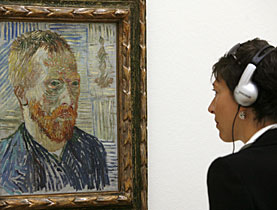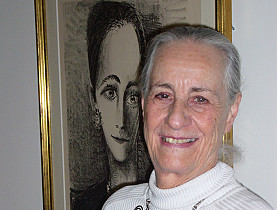Van Gogh’s legacy of landscapes unveiled

A spectacular exhibition has opened at Basel's Kunstmuseum – a world first – showing 70 landscape paintings by the tortured artistic genius, Vincent van Gogh.
Landscapes were a way for the Dutch artist to express himself. They also show another side to the painter, one that rejoiced in and celebrated nature.
“The display has works that will probably never ever be assembled again in an exhibition,” exhibition curator Nina Zimmer told swissinfo. “We were able to get loans from all over the globe, many of them masterpieces in their respective collections.”
This includes Cypresses, on loan from the Museum of Modern Art in New York, and Harvest in Provence from the Israel Museum in Jerusalem.
Also on show at the exhibition, which opened on April 26 and runs for five months, are works which have rarely been seen before in public.
The Basel Kunstmuseum has therefore pulled off quite a coup. The curators are at a loss to explain why such a key part of van Gogh’s oeuvre has never before been highlighted, but Zimmer says it is probably because so many specific loans from each phase of his work were needed. For this reason the display took several years to organise.
Self-expression
“Landscapes are what van Gogh painted the most,” Zimmer said. “And they are really what he expresses himself with. Landscape was always there for him, he didn’t have to pay a model or convince a friend.”
As landscapes were also considered the lowest of the artistic genres in the 19th century, they were open to experimentation, she added.
“What van Gogh was trying to do is bring much more and stronger colour and a much larger impact to his canvases,” she explained.
Born into a pastor’s family in 1853, van Gogh tried his hand at being a preacher and a teacher before turning to art.
Largely self-taught, he left for Paris in 1880, where his brother Theo, a formative influence in his life, worked as an art dealer. The French capital was at that time a hub of the European art scene, home to Impressionists such as Claude Monet and Pierre-Auguste Renoir.
Earth-coloured to luminous
This deeply influenced van Gogh. Gradually the earth tones of his early Dutch work – as seen in his Flower Beds in Holland painting – gave way to a more luminous, atmospheric and colour-oriented technique. He started to show his works in exhibitions.
But van Gogh found Paris stressful and felt under increasing artistic pressure. In 1888 he departed for Arles, in Provence. The fresh, light colours and the warm atmosphere inspired him and he produced 200 paintings in just over a year.
Harvest in Provence, showing the golden colours of the wheat fields, set against the bluest of skies, dates from this time.
Van Gogh invited his Paris friends to Arles with dreams of setting up an artistic community there, but only Paul Gauguin accepted.
Crisis in Provence
It was not a happy visit. The relationship between the effusive Gauguin and the tense van Gogh suffered from friction. After a particularly nasty confrontation, the Dutchman cut off part of his left ear and Gauguin left.
By now frightened by his behaviour, van Gogh checked in voluntarily to a sanatorium near Saint-Rémy. He began to paint again, at first the view from his window and then outdoors.
“In Saint-Rémy we see how the already immediate and very colourful brushstrokes of the Arlesian period are again heightened and his expression exaggerated until every single leaf and every single root of an olive tree is charged with a dynamic energy and the paintings are vibrating from this dynamic force,” Zimmer told swissinfo.
In May 1890 he moved back north to Auvers-sur-Oise, where he was placed under the care of doctor and amateur artist Paul Gachet.
He painted almost 80 pictures at Auvers, mostly landscapes and portraits, but the idyll was not to last. On July 27 he shot himself with a pistol and died two days later, aged 37.
Nature and harmony
“We know that he felt lonely and depressed throughout his life,” Zimmer said. “But in his landscapes we also see the other side of him, someone who can really be in harmony with himself and God’s creation.”
Van Gogh was not an active churchgoer but he did believe in God. Painting nature was “a sort of worship” for him, believes the curator.
He was particularly interested in nature’s cyclical quality, incorporating into his works subjects such as the farmer and the mower, as well as blossoming trees and the harvest.
In addition we see snapshots of his world – village and urban landscapes, the sea, gardens and parks, olive groves and vineyards.
The aim is to show “the continuity of his artistic search for his own personal style”, says Zimmer.
Artistic legacy
Van Gogh’s fame grew after his death and many of his work rank among the most popular worldwide, fetching high prices at auction.
The artist also had a strong influence on 20th century post-Impressionist painting, particularly on the Expressionists.
The museum is expecting around 500,000 visitors and hopes that people will get to know van Gogh in a new light.
“I hope that they will enjoy the quality of van Gogh’s work and will discover this great artist anew,” Zimmer said. “And maybe forget about some of the clichés about him that they had in mind.”
swissinfo, Isobel Leybold-Johnson in Basel
Vincent van Gogh – Between Earth and Heaven: The landscapes is showing at the Basel Kunsthaus until September 27, 2009.
Seventy paintings by van Gogh are on show. The best known is Cypresses from the MoMA in New York.
The exhibition in Basel has been styled the most important art event in Europe in 2009.
Also on display separately are 40 paintings by van Gogh’s contemporaries from the Kunstmuseum’s collection, including Monet, Pissarro, Degas and Gauguin.

In compliance with the JTI standards
More: SWI swissinfo.ch certified by the Journalism Trust Initiative












You can find an overview of ongoing debates with our journalists here . Please join us!
If you want to start a conversation about a topic raised in this article or want to report factual errors, email us at english@swissinfo.ch.